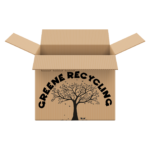
Insights
How is Cardboard Made?
Cardboard is one of the most commonly used materials in packaging, especially among small businesses. From shipping boxes to retail packaging, it’s a vital part of many business operations. What makes cardboard even more appealing is its recyclability, allowing businesses to reduce their environmental footprint. But have you ever thought about how cardboard is made in the first place? Here’s a detailed breakdown of the cardboard-making process, and why it matters for recycling.
1. Raw Material Sourcing: Where Does It All Start?
Cardboard is primarily made from wood fibers, which come from trees, but a significant amount of cardboard today is also produced using recycled paper and cardboard products. These wood fibers are found in softwood trees such as pine and fir, which have long, strong fibers ideal for making durable cardboard. The use of recycled paper reduces the need for virgin tree fibers, which is a key benefit for businesses focused on sustainability.
- Virgin Fibers vs. Recycled Fibers: When cardboard is made using virgin wood fibers, the production process starts with tree harvesting. For recycled cardboard, however, the process begins with collecting and sorting discarded paper or cardboard.
By choosing to purchase packaging made from recycled cardboard or recycling your own, your business can help reduce the need for tree harvesting and lower the industry’s reliance on virgin materials.
2. Pulping: Breaking Down the Materials
Once the raw materials (wood or recycled cardboard) are collected, they are sent to a paper mill where the pulping process begins. Pulping is the process of breaking down the wood chips or recycled materials into small fibers, creating a mixture known as slurry. This slurry is made of about 99% water and 1% fibers. The water helps to separate and suspend the fibers, which are then cleaned and refined.
If the cardboard is being made from recycled materials, this step also involves removing any inks, adhesives, or coatings from the old cardboard. This cleaning ensures that the fibers are ready to be re-formed into new cardboard.
3. Screening and Bleaching: Prepping the Fibers
Once the slurry is formed, it goes through a screening process to remove any large contaminants like dirt or plastic. After screening, the slurry may be bleached to remove color if white or lighter-colored cardboard is desired.
Recycled fibers can sometimes result in lower-quality cardboard due to shorter fiber lengths, but blending virgin fibers with recycled ones often solves this issue, resulting in strong, durable packaging.
4. Forming the Paper: The Foundation of Cardboard
After the slurry is cleaned and refined, it’s spread over large screens to drain the water, leaving behind a mat of fibers. This fiber mat is then pressed to remove excess water and form sheets of paper, which are rolled into large spools.
Cardboard consists of multiple layers of this paper, which can vary depending on the thickness and strength required. There are two main types of cardboard:
- Paperboard: This is the simple, flat type of cardboard used in items like cereal boxes or product packaging.
- Corrugated Cardboard: This is the stronger, thicker type used in shipping boxes. It consists of three layers – two flat sheets of paperboard with a fluted (wavy) layer in the middle.
5. Corrugation: Adding Strength
For corrugated cardboard, the central step is forming the fluted layer. A machine called a corrugator shapes the paper into the characteristic wavy (corrugated) pattern. This fluted paper is then sandwiched between two flat sheets of paperboard to form corrugated cardboard. The fluted layer gives the material its strength, making it suitable for heavy-duty packaging and shipping.
Depending on the requirements, additional layers may be added for extra strength. For instance, double-walled or even triple-walled corrugated cardboard is used for particularly heavy or fragile items.
6. Cutting and Shaping: Ready for Use
Once the cardboard is formed, it is cut into various shapes and sizes depending on its end use. For shipping boxes, the sheets are die-cut into flat, foldable patterns that can be assembled into boxes. Cardboard packaging can also be printed on, laminated, or coated to meet different needs, from branding to moisture resistance.
7. The Environmental Impact: Why Recycling Matters
Producing cardboard from virgin materials requires significant energy, water, and resources, including large amounts of wood. Recycling, however, reduces these demands by reusing fibers from discarded products. For small businesses, recycling cardboard can reduce waste disposal costs, cut energy use, and lower the demand for new raw materials.
- Energy Savings: It’s estimated that recycling cardboard saves up to 25% of the energy required to produce new cardboard.
- Landfill Reduction: Cardboard is one of the largest components of municipal solid waste, and recycling it reduces the amount of waste sent to landfills.
- Greenhouse Gas Reduction: By recycling, your business can also lower its carbon footprint, as producing cardboard from recycled materials emits fewer greenhouse gases than from virgin materials.
8. Why Should Your Business Care About Cardboard Recycling?
As a small business owner, sustainability isn’t just about protecting the planet; it can also save you money. Implementing a cardboard recycling program in your business helps reduce disposal costs and may even allow you to sell or donate your recycled materials to local recycling centers. Additionally, using packaging made from recycled cardboard appeals to eco-conscious customers, who increasingly prefer companies that prioritize environmental responsibility.
Cardboard’s journey from trees or recycled materials to the packaging you use every day is an intensive process, but one that can be made more sustainable through recycling. By understanding how cardboard is made, small business owners can make better decisions about their packaging, waste management, and recycling programs. Choosing recycled cardboard and properly recycling used cardboard can help your business reduce its environmental footprint and contribute to a more circular economy. Reach out to Greene Recycling today to schedule your cardboard bale pickup!
